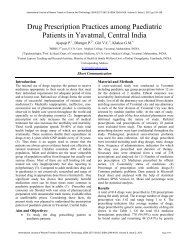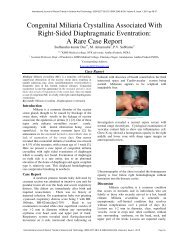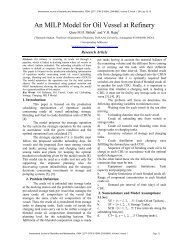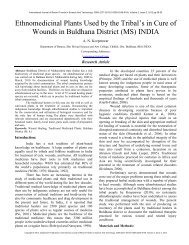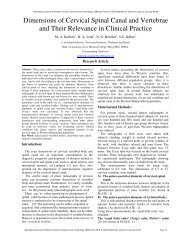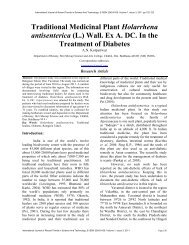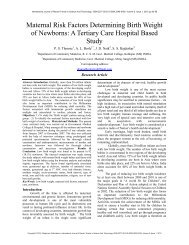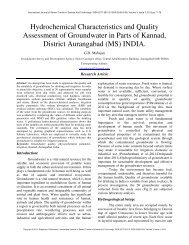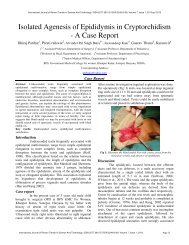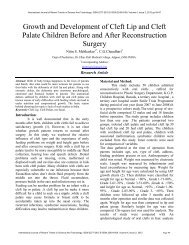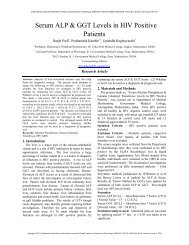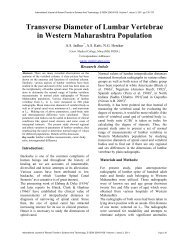Green Waste As a Resource for Value Added Product ... - Statperson
Green Waste As a Resource for Value Added Product ... - Statperson
Green Waste As a Resource for Value Added Product ... - Statperson
Create successful ePaper yourself
Turn your PDF publications into a flip-book with our unique Google optimized e-Paper software.
International Journal of Recent Trends in Science And Technology, ISSN 2277-2812 E-ISSN 2249-8109, Volume 4, Issue 1, 2012 pp 22-33<br />
<strong>Green</strong> <strong>Waste</strong> <strong>As</strong> a <strong>Resource</strong> <strong>for</strong> <strong>Value</strong> <strong>Added</strong><br />
<strong>Product</strong> Generation: A Review<br />
Vivek P. Bhange a,* , SPM. Prince William b , A.N.Vaidya b , A.R.Chokhandre d<br />
a,d Department of Biotechnology, Priyadarshini Institute of Engineering & Technology, Nagpur-19 (MS) INDIA.<br />
b Solid <strong>Waste</strong> Management Division, National Environmental Engineering Research Institute, Nehru Marg,<br />
Nagpur-20 (MS) INDIA<br />
* Corresponding Address:<br />
vivek_bhange@yahoo.co.in<br />
Review Article<br />
Abstract: <strong>Green</strong> waste includes foliage, plant residues, fallen<br />
flowers, garden refuse, leaf litter, cut grass, residues of pruning,<br />
weeds and other organic matter discarded from gardens and<br />
greeneries but exclude organic waste of the type obtained from<br />
municipal collections. These green wastes would land in dumping<br />
sites, or will be burned, if not collected and processed contributing<br />
to the large scale contamination of land, water and air. Leaves<br />
accumulating in the urban and suburban locations such as<br />
sidewalks, lawns, and playgrounds are not only an unseemly sight<br />
but adds to the overall problem of municipal solid waste (MSW)<br />
disposal. In India and several other countries, foliage is often piledup<br />
and set on fire. The resulting ash returns some of the NPK<br />
content of the foliage to the soil but much of nitrogen,<br />
phosphorous, and organic carbon gets lost. The burning of leaves<br />
also adds to air pollution and global warming. <strong>Green</strong> waste when<br />
decomposes in soil may release methane and foul odors, be<strong>for</strong>e<br />
getting converted into humus. However green waste can be a<br />
potential resource <strong>for</strong> energy and other value added products, if<br />
properly processed. The present review aims at summarizing<br />
different processing options <strong>for</strong> green waste towards energy<br />
production and value added product generation. <strong>Green</strong> waste is<br />
mostly dealt with aerobic treatment (composting), anaerobic<br />
treatments, incineration, biomass briquetting, cellulosic ethanol<br />
from biomass, biohydrogen production, bioplastics etc.<br />
Keywords: <strong>Green</strong> waste, Aerobic processing, Anaerobic Treatment,<br />
Briquetting, Cellulosic ethanol, Bioplastics, Biohydrogen<br />
production<br />
1. Introduction<br />
Maintenance of green spaces such as home<br />
gardens, parks, lawns and other green interiors<br />
produces a significant amount of green waste, includes<br />
foliage, plant residues, decayed and fallen flowers,<br />
garden refuse, leaf litter, cut grass, pruned things of<br />
trees, weeds and other organic matter discarded from<br />
gardens but exclude organic waste of the type obtained<br />
from municipal collections.<br />
India is blessed with huge land cover,<br />
relatively high population density, and green<br />
consciousness, much land is left undeveloped. The<br />
number of parks and other recreational centers, home<br />
gardens etc. contribute to the increasable quantum of<br />
garden biomass generation. Consequently,<br />
maintenance of green areas produces a significant<br />
amount of waste [1] .The total annual production of<br />
leafy biomass in India is of the order of 1130 million<br />
tons [2] . This green waste would land in dumping sites,<br />
or will be burned if not collected and processed<br />
contributing to the large scale contamination of land,<br />
water and air. Although not in focus as much as<br />
domestic green waste such as foliage, grass, and plant<br />
residues, is a major constituent of solid waste [3[ .Leaves<br />
accumulating in the urban and suburban locations such<br />
as sidewalks, lawns, and playgrounds are not only an<br />
unseemly sight but adds to the overall problem of<br />
municipal solid waste disposal [4] . Road sweepings and<br />
road side plantations are some areas which generate<br />
significant biomass waste [5] . Leaving a thick layer of<br />
leaves on your lawn or garden can create conditions<br />
that lead to rotting of the grass or perennials beneath.<br />
In India and several other countries foliage is often<br />
piled-up and set on fire. The resulting ash returns some<br />
of the NPK content of the foliage to the soil but much<br />
of nitrogen, phosphorous, and organic carbon gets lost.<br />
The burning of leaves also adds to air pollution and<br />
global warming [4] . <strong>Green</strong> waste when decomposes in<br />
soil may release methane and foul odors, be<strong>for</strong>e getting<br />
converted to humus. Leaves and yard trimmings can be<br />
harmful to lakes and streams after washing into storm<br />
sewers [3] .The use of green waste as a raw material can<br />
broaden the options giving it more flexibility and a<br />
broader application range because it would (1) rely on<br />
more-biodegradable products and processes that create<br />
less pollution and generally have fewer harmful<br />
environmental impacts; (2) develop less expensive<br />
products;(3) use less expensive raw materials [6],[7] .<br />
International Journal of Recent Trends in Science And Technology, ISSN 2277-2812 E-ISSN 2249-8109, Volume 4, Issue 1, 2012 Page 22
Vivek P. Bhange, SPM. Prince William, A.N. Vaidya, A.R. Chokhandre<br />
<strong>Green</strong> waste contains recalcitrant or complex<br />
compounds such as cellulose and lignin, and relatively<br />
small amounts of saccharides, amino acids, proteins,<br />
aliphatic compounds and carbohydrates [1],[8]. .The main<br />
components of plant biomass are carbohydrates<br />
(approximately 75%, dry weight) and lignin<br />
(approximately 25%), which can vary with plant type.<br />
The carbohydrates are mainly cellulose or<br />
hemicellulose fibers, which impart strength to the plant<br />
structure, and lignin, which holds the fibers together.<br />
Some plants also store starch (another carbohydrate<br />
polymer) and fats as sources of energy, mainly in seeds<br />
and roots [7] . The characterization of green waste is<br />
given in Table 1. The green waste is amenable to<br />
biodegradation by composting as they have major<br />
concentrations of heterogeneous organic substrates,<br />
including sugars, fats, proteins, hemicelluloses,<br />
celluloses, and lignin [11] .The other options <strong>for</strong><br />
economical means of green waste processing are:<br />
anaerobic treatments, incineration, biomass briquetting,<br />
cellulosic ethanol from biomass, biohydrogen<br />
production, bioplastics etc.<br />
Table 1: Characterization of green waste [9,10]<br />
Paramater <strong>Waste</strong> Leaves Grass Branches Yard<br />
Total organic carbon(% dw)<br />
C/N Ratio<br />
Fats/lipids(% dw)<br />
Cellulose(% dw)<br />
Hemicellulose(% dw)<br />
Lignin/humus(% dw)<br />
Volatile Solids(% dw)<br />
Cellulose/lignin ratio<br />
30.1<br />
21.6<br />
2.59<br />
9.48<br />
3.24<br />
33.88<br />
63.3<br />
0.28<br />
40.6<br />
17.5<br />
2.41<br />
39.67<br />
16.89<br />
17.63<br />
81.7<br />
2.25<br />
40.4<br />
13.1<br />
1.04<br />
14.71<br />
12.87<br />
42.89<br />
81.7<br />
0.34<br />
36.2<br />
18.7<br />
2.49<br />
27.20<br />
11.25<br />
24.34<br />
73.8<br />
1.12<br />
2. Technologies available <strong>for</strong> green waste<br />
processing<br />
2.1Aerobic processing (composting)<br />
Composting is the biological oxidative<br />
decomposition of organic constituents in wastes under<br />
controlled conditions. It requires special conditions,<br />
temperature, moisture, aeration, pH and C/N ratio, to<br />
enable optimum biological activity during the different<br />
stages of composting [12],[13] . The main products of<br />
aerobic composting are CO 2 , H 2 O, mineral ions and<br />
stabilized organic matter, often called humus. CO 2 and<br />
water losses can amount to half the weight of the initial<br />
materials. The major groups of microorganisms that<br />
participate in composting are bacteria, fungi, and<br />
actinomycetes. The process is accomplished through<br />
different phases i.e. initial phase during which readily<br />
degradable components are decomposed 14 . During a<br />
thermophilic phase cellulosic materials are oxidatively<br />
degraded rapidly by microbes. This is followed by<br />
maturation and stabilization phases [15] .<br />
Rihani et al. (2010) used sugar beet leaves and<br />
produced compost with low amounts of heavy metals,<br />
relatively high contents of nutrients and significant<br />
reduction of pathogens, suggesting the significance of<br />
processing agricultural green waste <strong>for</strong> compost<br />
production [16] . Kumar et al. (2010) studied the cocomposting<br />
of food waste and green waste at low<br />
initial carbon to nitrogen (C/N) ratios in-vessel labscale<br />
composting reactor they found optimal moisture<br />
content <strong>for</strong> co-composting is 60%, and the substrate at<br />
a C/N ratio of 19.6 can be decomposed effectively to<br />
reduce 33% of total volatile solids (TVS) in 12 days<br />
[17] .<br />
Similarly, Kalamdhad et al. (2009)<br />
investigated rotary drum composting of vegetable<br />
waste and tree leaves and produced quality compost<br />
with a total nitrogen content of 2.6% and total<br />
phosphorus as 6 g/kg. They suggested that institutional<br />
organic waste, i.e. vegetable wastes and tree leaves,<br />
etc., can be composted successfully within 7 days<br />
period in a rotary drum composter by maintaining<br />
aerobic conditions through passive air supply by<br />
exhaust fan [18] .Tai and He (2007) reported a novel<br />
composting process <strong>for</strong> plant wastes from gardening,<br />
such as leaves, grass and flowers in Taiwan military<br />
barracks. The time required to complete composting is<br />
shortened to 2–3 months [1] .<br />
Gajalakshmi and Abbasi (2004) evaluated<br />
neem leaves as a source of fertilizer-cum-pesticide<br />
vermicompost. Vermicomposting of neem<br />
(Azadirachta indica A.Juss) was accomplished in highrate<br />
reactors operated at the earthworm (Eudrilus<br />
eugeniae) densities of 62.5 and 75 animals per litre of<br />
reactor volume [19] . They (Gajalakshmi et al. 2005) also<br />
studied vermicomposting of leaf litter ensuing from the<br />
trees of mango (Mangifera indica). After over nine<br />
months of continuous operation the vermireactors with<br />
62.5 animals l -1 generated 13.6g vermicast per litre of<br />
reactor volume (l) per day (d) whereas the reactors<br />
with 75 animals l -1 produced 14.9g vermicast l -1 d -1 [4] .<br />
Wong et al (2001) evaluated the feasibility of<br />
co-composting of soybean residues and leaves and the<br />
effects of turning frequency on compost quality.<br />
Soybean residues were mixed with leaves and sawdust<br />
in 1:1:3 (w/w wet weight) <strong>for</strong> achieving a C/N ratio of<br />
about 30. All treatments with different turning<br />
frequencies reached maturation at 63 days as indicated<br />
by the soluble organic carbon, soluble NH 4 -N, C/N<br />
ratio and cress seed germination index [20] .<br />
Almost any organic material is suitable <strong>for</strong><br />
composting process. The materials need a proper ratio<br />
Copyright © 2012, <strong>Statperson</strong> Publications, International Journal of Recent Trends in Science And Technology, ISSN 2277-2812 E-ISSN 2249-8109, Volume 4, Issue 1, 2012
International Journal of Recent Trends in Science And Technology, ISSN 2277-2812 E-ISSN 2249-8109, Volume 4, Issue 1, 2012 pp 22-33<br />
of carbon-rich materials ‘browns’ and nitrogen-rich<br />
materials ‘greens’. Among the brown materials are<br />
dried leaves, straw and wood chips. Nitrogen materials<br />
are fresh or green such as grass clippings and kitchen<br />
scraps. The carbon provides energy <strong>for</strong> the microbes,<br />
and the nitrogen provides proteins. Achieving the best<br />
mix is more an art gained through experience than an<br />
exact science. The change in the C/N ratios reflects the<br />
organic matter decomposition and stabilization<br />
achieved during composting [21] .<br />
The decomposition of organic matter is<br />
brought about by living organisms, which utilize<br />
carbon as a source of energy and the nitrogen <strong>for</strong><br />
building cell structures. If the C/N ratio of compost is<br />
more, the excess carbon tends to utilize nitrogen in the<br />
soil to build cell protoplasm. This results in loss of<br />
nitrogen of the soil and is known as robbing of<br />
nitrogen in the soil. If on the other hand the C/N ratio<br />
is too low the resultant product does not help improve<br />
the structure of the soil. It is hence desirable to control<br />
the process so that the final C/N ratio is less than or<br />
equal to 20 [18],[22] .<br />
2.1.1 Advantages of green waste composting<br />
<strong>Green</strong> waste composting is an environment<br />
friendly method as it produces fairly hygienic<br />
products.<br />
During incubation process the high<br />
temperatures were successfully went through<br />
as problems of foul odour and presence of<br />
pathogenic organism were not<br />
observed//minimized/reduced.<br />
It is easy to carry out and produces products<br />
that deliver fertilizer efficiency between<br />
humic soil and organic fertilizer.<br />
Composting is an appropriate method to deal<br />
with the green waste <strong>for</strong> military barracks,<br />
schools, institutions and commercial areas<br />
which consist of large green areas,<br />
undeveloped land and plenty of labor.<br />
Large quantities of green waste can be<br />
managed in sustainable matter.<br />
Organic matter and nutrients return to the<br />
natural cycle through the application of<br />
compost to the soil.<br />
Activity of earthworms and other natural soil<br />
organisms beneficial <strong>for</strong> plant growth<br />
increases with the use of compost [23], [24] .<br />
2.1.2 Disadvantages<br />
<br />
<br />
<br />
Long time duration, space requirement and<br />
need <strong>for</strong> manpower are the major shortcomings<br />
<strong>for</strong> this eco-friendly technology.<br />
<strong>As</strong> it contains only limited levels of plant<br />
nutrients compost is a soil emendation, not a<br />
fertilizer.<br />
Loss of nitrogen, VOCs, protracted processing<br />
and curing time, cost of equipment, and the<br />
challenge of augmenting a successful<br />
marketing plan <strong>for</strong> compost.<br />
<strong>As</strong> an outcome of modernization, the<br />
constituents of waste is changing that<br />
comprises of pesticides, polychlorinated biphenyls,<br />
heavy metals in high concentrations<br />
resulting in the compost that is undesirable <strong>for</strong><br />
land application. [82],[86] .<br />
2.2 Anaerobic Treatment<br />
Anaerobic digestion is a series of processes in<br />
which microorganisms break down biodegradable<br />
material in the absence of oxygen. In the first step<br />
polymers like starch, cellulose, lipids, proteins are<br />
hydrolyzed to amino acids, sugars, fatty acids etc. In<br />
the process of acidogenesis these are converted into a<br />
mixture of hydrogen gas, low molecular weight acids<br />
like acetic acid and carbon dioxide. In the process of<br />
methanogenesis these are reacted together to generate<br />
methane. Anaerobic digestion is broadly used as a<br />
renewable energy source because the process produces<br />
biogas which is rich in methane and carbon dioxide<br />
suitable <strong>for</strong> the production of energy that can replace<br />
fossil fuels. The digestate left after biogas production is<br />
rich in nutrient value and can be used as fertilizer.<br />
Jagadabhi et al. (2011) demonstrated about the<br />
two stage anaerobic digestion of tomato, tree leaves<br />
and grass silage in leach bed reactor (LBR) and up<br />
flow anaerobic sludge blanket reactor (UASB). LBR<br />
studies showed that COD solubilization <strong>for</strong> tree leaves<br />
and grass silage was higher (50%) than tomato (35%)<br />
and leaves (15%). Biomethanation of the leachates in<br />
UASB reactors resulted in methane yields of 0.03–<br />
0.14 m 3 CH 4 kg −1 VS fed <strong>for</strong> the studied crop materials<br />
[25] . Kaparaju et al. (2010) investigated the biogas<br />
production of wheat silage in UASB reactor by<br />
thermophilic anaerobic digestion batch and continuous<br />
mode. In batch experiments at two different substrate<br />
concentrations results showed higher methane yields<br />
over continuous method [26] .<br />
Prochnow et al. (2009) summarized<br />
knowledge on suitability and sustainability of<br />
grassland biomass <strong>for</strong> anaerobic digestion. Methane<br />
International Journal of Recent Trends in Science And Technology, ISSN 2277-2812 E-ISSN 2249-8109, Volume 4, Issue 1, 2012 Page 24
Vivek P. Bhange, SPM. Prince William, A.N. Vaidya, A.R. Chokhandre<br />
yields from grass are influenced by many factors.<br />
While the effects of some parameters such as grass<br />
species, cutting period and management intensity can<br />
be regarded as well known, other parameters such as<br />
preservation and processing still need investigation.<br />
Profitability can be achieved depending on grass silage<br />
supply costs and the concept of anaerobic digestion<br />
and energy use. Grassland biomass <strong>for</strong> biogas<br />
production competes with other feedstock and other<br />
<strong>for</strong>ms of grassland use [27] .<br />
Lehtomaki.et al.(2008) conducted anaerobic<br />
digestion of grass silage in batch leach bed processes<br />
<strong>for</strong> methane productions, with and without a second<br />
stage upflow anaerobic sludge blanket (UASB) reactor.<br />
66% of the methane potential in grass was obtained<br />
within the 55 days solids retention time in the leach<br />
bed–UASB process without pH adjustment, whereas in<br />
the one-stage leach bed process 20% of the methane<br />
potential in grass was extracted. The methane potential<br />
of the digestates varied from 0.141 to<br />
0.204 m 3 CH 4 kg −1 added volatile solids [28] .<br />
Parawira et al. (2004) characterized anaerobic<br />
batch biodegradation of potato waste alone and codigested<br />
with sugar beet leaves. The effects of<br />
increasing concentration of potato waste expressed as<br />
percentage of total solids (TS) and the initial inoculumto-substrate<br />
ratio (ISR) on methane yield and<br />
productivity were investigated. Co-digestion improved<br />
the accumulated methane production and improved the<br />
methane yield by 31–62% compared with digestion of<br />
potato waste alone [29] .<br />
Yu et al. (2002) proposed a two phase<br />
anaerobic digestion using grass. The biphasic system<br />
consists of a solid phase and a methane phase.<br />
Leachate is recirculated through the solid phase until a<br />
desired level of volatile fatty acid is accumulated in the<br />
leachate. The leachate is then transferred to the<br />
methane reactor where volatile fatty acid is converted<br />
to methane. The system produced an average of 0.15m 3<br />
of methane per kg of grass. The average methane<br />
concentration in the produced gas was 71%. [30] .<br />
Sharma et al.(1999) operated the system is a<br />
batch digestion with a regular input of a calculated<br />
amount of plant biomasses based on first order decay<br />
kinetics in order to maintain a regular biogas<br />
production rate. For nearly three years the system was<br />
tested in a laboratory-scale fed-batch digester using<br />
dried water hyacinth as feed providing the desired<br />
biogas production rate. A field-scale domestic digester<br />
of masonry construction with a working volume of 10<br />
m 3 was designed and tested <strong>for</strong> about 9 months by<br />
feeding a mixture of dried water hyacinth or banana<br />
stem along with sugarcane press mud, yielding an<br />
average biogas production of 90–100% of the expected<br />
rate calculated on the basis of the feed rate [31] .<br />
Jagadish et al. (1998) developed plug flow<br />
digestors <strong>for</strong> biogas generation from leaf biomass. The<br />
long term operation of such biogas plants using a<br />
mixed green leaf biomass feedstock is reported along<br />
with its design features. Results show that during long<br />
term operation, such biogas plants have the ability to<br />
produce up to 0.5 m 3 gas/m 3 reactor/day (ambient<br />
conditions) at specific conversion rates ranging<br />
between 180 and 360 l biogas/kg TS (total solids) at a<br />
35 day retention time [32] .<br />
Gunaseelan (1988) studied anaerobic digestion<br />
of gliricidia leaves <strong>for</strong> biogas and organic manure<br />
.Gliricidia maculata is a tree grown in India <strong>for</strong> green<br />
leaf manuring. The digestibility of Gliricidia leaves <strong>for</strong><br />
biogas production was determined in 3 liter batch<br />
digesters at room temperature (32±3°C). Results<br />
indicate a gas yield of 165–180 ml CH 4 g −1 VS added<br />
and a VS reduction of 37–39%. Determination of the<br />
N, P, and K content of the digester influent and<br />
effluent slurries indicates that the anaerobically<br />
digested slurry of the Gliricidia leaves is better in<br />
quality than the fresh Gliricidia leaves as organic<br />
manure [33] .<br />
Ghosh et al. (1985) reported that Bermuda<br />
grass is deficient in nitrogen and phosphorus.<br />
Accordingly, several mesophilic digestion runs were<br />
conducted with Bermuda grass at HRT = 12 days and<br />
Organic Loading Rate = 1.6 kg VS m -3 d -l , with and<br />
without external nitrogen and phosphorus additions. It<br />
was found that supplementing the feed with NH 4 Cl<br />
increased the CH 4 yield by 96% and cellulose<br />
conversion by 33%. Nitrogen addition appeared to<br />
decrease hemicellulose conversion and phosphorus<br />
addition had no effect on hemicellulose conversion or<br />
CH 4 production. It was speculated that the metabolism<br />
of the breakdown product (glucose) of cellulose<br />
requires the least investment of enzymes and energy.<br />
The CH 4 yield from grass mixture was higher than that<br />
of Bermuda grass without external nutrient addition<br />
[5],[34], [35] .<br />
Anaerobic process in comparison to aerobic<br />
process can be ecologically advantageous when the<br />
factors like exhaust emissions and energy balances are<br />
considered. Anaerobic digestion has benefit over all<br />
other methods as there is net production of energy in<br />
the <strong>for</strong>m of biogas which when used prevents negative<br />
effects on environment. The preferred treatment<br />
Copyright © 2012, <strong>Statperson</strong> Publications, International Journal of Recent Trends in Science And Technology, ISSN 2277-2812 E-ISSN 2249-8109, Volume 4, Issue 1, 2012
International Journal of Recent Trends in Science And Technology, ISSN 2277-2812 E-ISSN 2249-8109, Volume 4, Issue 1, 2012 pp 22-33<br />
method depends on the composition and structure of<br />
the material. In general, structured materials with high<br />
lignocellulose content are less readily degradable under<br />
anaerobic conditions and are there<strong>for</strong>e more suitable<br />
<strong>for</strong> aerobic treatment. Anaerobic treatment is preferred<br />
<strong>for</strong> unstructured materials with a high content of<br />
readily-degradable organic compounds [36] .<br />
2.2.1 Advantages of anaerobic digestion of green<br />
waste<br />
Biomass sludge is produced in less quantity as<br />
compared to aerobic treatment technologies.<br />
The method proved successful in treating wet<br />
wastes having less than 40% dry matter.<br />
Produces minimal odour as 99% of volatile<br />
compounds are oxidatively decomposed upon<br />
combustion, e.g. H 2 S <strong>for</strong>ms SO 2.<br />
Slurry produced is an enhanced fertilizer <strong>for</strong><br />
plants due to its availability and rheological<br />
properties<br />
Biogas is produced which is a source of carbon<br />
neutral energy.<br />
Increased reaction rates as compared to the<br />
destruction of organic matter.<br />
It is a highly stable method with high<br />
depuration rate and energy recovery with a<br />
good process economy.<br />
Solar energy that is stored in the biomass is<br />
converted to an energy carrier (biogas) by<br />
anaerobic treatment.<br />
2.2.2 Disadvantages<br />
The pH in the reactor may decrease due to<br />
rapid acidification.<br />
Larger volatile fatty acids production (VFA)<br />
inhibits the activity of methanogenic bacteria.<br />
Increase in the feed concentration leads to the<br />
depletion of overall per<strong>for</strong>mance by the<br />
reactor.<br />
Anaerobic digestion is more expensive than<br />
composting [37] .<br />
3. Other Technologies<br />
3.1 <strong>Green</strong> waste Briquetting<br />
The process of compaction of residues into a<br />
product of higher density than the original raw material<br />
is known as briquetting [38] . Biomass briquettes are<br />
generally made from agricultural waste and are a<br />
replacement <strong>for</strong> fossil fuels such as oil or coal, and can<br />
be used to heat boilers in manufacturing plants, and<br />
also have applications in developing countries.<br />
Biomass briquettes are a renewable source of energy<br />
and avoid adding fossil carbon to the atmosphere. Use<br />
of biomass briquettes can earn Carbon Credits <strong>for</strong><br />
reducing emissions in the atmosphere. Biomass<br />
briquettes also provide more calorific value/kg and<br />
save around 30-40 percent of boiler fuel costs.<br />
Briquetting has aroused a great deal of interest<br />
in developing countries all over the world lately as a<br />
technique <strong>for</strong> upgrading of residues as energy sources.<br />
The process also helps to reduce de<strong>for</strong>estation by<br />
providing a substitute <strong>for</strong> fuel wood [38] . Two different<br />
types of briquetting technologies are currently in use.<br />
The first, called pyrolizing technology relies on partial<br />
pyrolysis of biomass, which is mixed with binder and<br />
then made into briquettes by casting and pressing. The<br />
second technology is direct extrusion type, where the<br />
biomass is dried and directly compacted with high heat<br />
and pressure. Setting up the briquette production unit<br />
raw material should be locally available [ 85] .<br />
Felfli et al. (2011) studied the status of<br />
biomass briquetting and its perspectives in Brazil<br />
including determination of the availability and<br />
characteristics of the agro-residues <strong>for</strong> briquetting.<br />
Wood residues, rice husk and coffee husk were<br />
characterized and identified as the more promising<br />
agro-residues <strong>for</strong> briquetting in the short-term in Brazil<br />
[39] . Yumak et al. (2010) used soda weed (Salsola<br />
tragus) as a rural fuel source <strong>for</strong> briquetting and found<br />
that moisture rates of 7–10%, pressure of 31.4 MPa,<br />
and temperatures of 85–105 °C were suitable <strong>for</strong><br />
briquetting soda weed [40] . Ma et al. (2002) established<br />
a new briquetting technology to simplify the<br />
briquetting process and reduce energy consumption, by<br />
utilizing the linkage function of biomass fiber. Results<br />
show that briquetting pressure to fix the linkage of<br />
biomass fiber is no more than 120 MPa, and a higher<br />
pressure causes a negative effect. The reasonable lower<br />
limit of biomass content is about 15%. Biomass drying<br />
in the air <strong>for</strong> a certain period (water content is<br />
generally less than 12%) is suitable <strong>for</strong> briquetting<br />
using the new mechanism [41] .<br />
Finell et al. (2002) made RCG (reed canarygrass,<br />
Phalaris arundinacea L.) an interesting new<br />
source of raw material <strong>for</strong> the pulp and paper industry<br />
in northern Europe. Pulp produced from briquetted<br />
RCG had more fines as compared to the non-briquetted<br />
reference material. Hand sheets produced using pulp<br />
from briquetted RCG were thinner, denser, and had<br />
lower air permeability compared to the non-briquetted<br />
reference material. The strength properties of pulp<br />
made from briquetted RCG indicated little or no<br />
difference compared to the reference material [42] .<br />
International Journal of Recent Trends in Science And Technology, ISSN 2277-2812 E-ISSN 2249-8109, Volume 4, Issue 1, 2012 Page 26
Vivek P. Bhange, SPM. Prince William, A.N. Vaidya, A.R. Chokhandre<br />
A study on briquettes from biomass was<br />
per<strong>for</strong>med by Yaman et al. (2001) in which a western<br />
Turkish lignite (Kütahya-Seyitömer) was blended with<br />
some biomass samples such as molasses, pine cone,<br />
olive refuse, sawdust, paper mill waste, and cotton<br />
refuse, and this blend was used in the production of<br />
fuel briquettes<br />
[43] . Paulrud and Nilsson (2001)<br />
investigated how spring-harvested reed canary-grass<br />
briquettes with various chemical compositions with<br />
respect to ash content influence the <strong>for</strong>mation of<br />
emissions during combustion in a 180 kW burner. The<br />
combustion experiments imply that spring-harvested<br />
reed canary-grass can be burned with success in<br />
combustion equipment that is designed <strong>for</strong> the<br />
differences in ash content [44] .<br />
Ali Moral (2000) evaluated biomass<br />
briquetting of biomass residues like rice husk, rice<br />
straw, wheat straw, maize stalk, sawdust, bagasse,<br />
coconut coir and groundnut shell. These residues found<br />
in a variety of <strong>for</strong>ms have high moisture content, low<br />
bulk residue, low heat release rate per unit volume and<br />
high transportation and storage costs when used as<br />
received [45] .<br />
3.1.1 Advantages <strong>Green</strong> waste Briquetting<br />
Biomass briquettes offer many benefits over<br />
traditional fuels like coal, fuel oil, natural gas and<br />
propane as well as over the pre-compacted raw<br />
materials like wood chips, paper, green wood etc.<br />
The purchase price of biomass briquettes is<br />
less than natural gas, propane and fuel oil.<br />
Compacting biomass waste into briquettes<br />
reduces the volume by 10 times, making it<br />
much easier to store and transport.<br />
They have a long shelf-life.<br />
Briquettes are immeasurably cleaner than the<br />
<br />
other fuel alternatives.<br />
Briquettes burn in a controlled manner, slow<br />
and efficiently [46] .<br />
<strong>Product</strong> has consistent quality, burning<br />
efficiency also ideally sized <strong>for</strong> complete<br />
combustion.<br />
<br />
<br />
<br />
It helps to solve the problem of residue<br />
disposal.<br />
It is one of the alternatives to save the<br />
consumption and dependency on fuel wood.<br />
The technology used is pollution free and ecofriendly<br />
[83] .<br />
3.1.2 Disadvantages<br />
High investment cost.<br />
High maintenance cost [47] .<br />
3.2 Cellulosic ethanol from green waste<br />
<strong>Green</strong> waste is a popular cellulosic material <strong>for</strong><br />
ethanol production. <strong>As</strong> world reserves of petroleum are<br />
depleting fast, in recent years ethanol has emerged as<br />
most important alternative resource <strong>for</strong> liquid fuel and<br />
has generated a great deal of research interest. The<br />
research on improving ethanol production has been<br />
accelerated <strong>for</strong> both ecological and economical<br />
reasons, mainly <strong>for</strong> its use as an alternative to<br />
petroleum based fuels. The most abundant organic raw<br />
material in the world is lignocellulosic biomass;<br />
production of ethanol from renewable lignocellulosic<br />
resources may improve energy availability. Utilization<br />
of these wastes will reduce dependency on <strong>for</strong>eign oil<br />
and secondly, this will remove disposal problem of<br />
wastes and make environment safe from pollution [48] .<br />
Pretreatment is prerequisite to make lignocellulosic<br />
biomass accessible to enzymatic attack (either by<br />
microorganisms or enzymes), by breaking the lignin<br />
seal, removing hemicellulose, or disrupting the<br />
crystalline structure of cellulose. Pretreatment alters<br />
the structural features of biomass which are classified<br />
as physical or chemical. The chemical structural<br />
features involve the compositions of cellulose,<br />
hemicellulose, lignin, and acetyl groups bound to<br />
hemicellulose whereas physical structural features<br />
include the accessible surface area, the crystallinity,<br />
and the physical distribution of lignin in the biomass<br />
matrix, the degree of polymerization, the pore volume,<br />
and the biomass particle size [49] .<br />
<strong>Product</strong>ion of ethanol from green waste has the<br />
abundant and diverse raw material compared to sources<br />
like corn and cane sugars, but requires a greater<br />
amount of processing such as physical and chemical<br />
fiber pre-treatments including: grinding, pyrolysis,<br />
steam explosion, ammonia fiber explosion, CO 2<br />
explosion, ozonolysis, acid hydrolysis, alkaline<br />
hydrolysis, oxidative delignification, organic solvent<br />
and biological pretreatment of the lignocellulosic<br />
materials to remove lignin and hemicellulose and<br />
reduce fiber crystallinity [50] .<br />
Jutakanoke et al. (2012) investigated the<br />
susceptibility of sugarcane leaves to cellulase<br />
hydrolysis by GC220 cellulase in the presence of either<br />
dilute sulfuric acid or lime. The acid pretreated<br />
samples released more glucose than the lime treated<br />
ones (5.7% and 3.9% weight by weight (w/w, DS),<br />
respectively). Fermentation of the obtained glucose<br />
sources by Saccharomyces cerevisiae <strong>for</strong> 12 and 24 h,<br />
respectively, yielded ethanol at 4.8% and 8.0% (w/w,<br />
DS), respectively [51] . Xu et al. (2011) demonstrated<br />
Copyright © 2012, <strong>Statperson</strong> Publications, International Journal of Recent Trends in Science And Technology, ISSN 2277-2812 E-ISSN 2249-8109, Volume 4, Issue 1, 2012
International Journal of Recent Trends in Science And Technology, ISSN 2277-2812 E-ISSN 2249-8109, Volume 4, Issue 1, 2012 pp 22-33<br />
Bermuda grass as a promising feedstock <strong>for</strong> the<br />
production of fuel ethanol. A variety of chemical,<br />
physico-chemical, and biological pretreatment methods<br />
have been investigated to improve the digestibility of<br />
Bermuda grass with encouraging results [52] . Romero-<br />
Anaya et al. (2011) investigated phosphoric acid<br />
activation at 450 °C of recalcitrant biomass originated<br />
in ethanol production from banana plants. The results<br />
are quite reproducible, showing good porosity<br />
developments and a strong dependence on the<br />
precursor, the H 3 PO 4 concentration and the<br />
H 3 PO 4 /sample weight ratio used [53] .<br />
Gabhane et al. (2011) tested the influence of<br />
heating source (Hot plate (HP), Autoclave (AC) &<br />
Microwave (MW) <strong>for</strong> their efficiency to pretreat<br />
garden biomass (GB).The results indicated that all<br />
three heating devices are useful <strong>for</strong> pretreatment,<br />
however, the efficiency of MW on GB was found be<br />
better than AC and HP. A maximum of 53.95% of<br />
cellulose recovery was obtained in case of MW heating<br />
along with 46.97% of reducing sugar yield. This when<br />
compared to AC and HP is significantly higher (more<br />
than 10% increase) and time saving (only 15 min<br />
reaction time) as well [54] .<br />
Behera et al. (2010) carried out the batch<br />
fermentation of mahula (Madhuca latifolia L. a tree<br />
commonly found in tropical rain <strong>for</strong>est) flowers using<br />
immobilized cells (in agar-agar and calcium alginate)<br />
and free cells of Saccharomyces cerevisiae. The<br />
ethanol yields were 151.2, 154.5 and 149.1 g kg −1<br />
flowers using immobilized and free cells, respectively<br />
[55] . Kaparaju et al. (2009) investigated the production<br />
of bioethanol, biohydrogen and biogas from wheat<br />
straw within a biorefinery framework. Initially, wheat<br />
straw was hydrothermally liberated to a cellulose rich<br />
fiber fraction and a hemicellulose rich liquid fraction<br />
(hydrolysate). Enzymatic hydrolysis and subsequent<br />
fermentation of cellulose yielded 0.41 g-ethanol/gglucose,<br />
while dark fermentation of hydrolysate<br />
produced 178.0 ml-H 2 /g-sugars [56] .<br />
Felix and Tilley (2009) studied on integrated<br />
energy, environmental and financial analysis of ethanol<br />
production from cellulosic switchgrass [57] . Hamelinck<br />
et al. (2005) evaluated the state of the art of hydrolysisfermentation<br />
technologies to produce ethanol from<br />
lignocellulosic biomass, which is based on dilute acid<br />
hydrolysis, has about 35% efficiency from biomass to<br />
ethanol. The overall efficiency, with electricity coproduced<br />
from the not fermentable lignin, is about<br />
60%. Improvements in pre-treatment and advances in<br />
biotechnology, especially through process<br />
combinations can bring the ethanol efficiency to 48%<br />
and the overall process efficiency to 68% [58] .<br />
3.2.1 Advantages of green waste cellulosic ethanol<br />
production<br />
Renewable transportation fuel.<br />
The raw material <strong>for</strong> cellulose ethanol<br />
production is plentiful as cellulose is present in<br />
every plant [59] .<br />
Cellulosic ethanol exhibits net energy content<br />
three times higher than corn ethanol.<br />
3.2.2 Disadvantages<br />
Requires a greater amount of processing.<br />
High cost of cellulose enzymes is the key<br />
barrier to economic production of cellulosic<br />
ethanol.<br />
3.3 Bioplastics<br />
Bioplastics is the designation <strong>for</strong> innovative<br />
plastics manufactured from regenerative raw materials.<br />
They can replace the previously used fossil plastics and<br />
plastic materials in many applications. Apart from<br />
wood, cellulose is the most significant renewable<br />
resources in terms of quantities; around 1.3 billion<br />
tones are annually harvested <strong>for</strong> technical applications<br />
world-wide. However, chemical processes are<br />
necessary to separate the cellulose fibers from<br />
undesired by-products such as lignin and pentoses.<br />
Cellulose has potentials in the production of plastics.<br />
For example, cellulose esters are amorphous<br />
thermoplastics which contain special plasticizers or are<br />
modified with other polymers. They are characterized<br />
by high toughness and are often used as polymer<br />
components in compounds with other bioplastics [60] .<br />
Striving to achieve cost-competitive biomassderived<br />
materials <strong>for</strong> the plastics industry, the<br />
incorporation of starch (corn and potato) to a base<br />
<strong>for</strong>mulation of albumen and glycerol was considered.<br />
Gonzalez-Gutierrez et.al. (2010) studied the effects of<br />
<strong>for</strong>mulation and processing, albumen/starch-based<br />
bioplastics containing 0–30 wt. % starch were prepared<br />
by thermo-plastic and thermo-mechanical processing.<br />
Consequently, albumen biopolymers may become a<br />
biodegradable alternative to oil-derived plastics <strong>for</strong><br />
manufacturing transparent packaging and other plastic<br />
stuffs [61] .<br />
Yu and Stahl (2008) utilized sugarcane<br />
bagasse <strong>for</strong> production of biopolyster. Sugarcane<br />
bagasse was pretreated in dilute acid solution, releasing<br />
sugars and other hydrolysates. Poly (3-<br />
hydroxybutyrate) was the predominant biopolyester<br />
International Journal of Recent Trends in Science And Technology, ISSN 2277-2812 E-ISSN 2249-8109, Volume 4, Issue 1, 2012 Page 28
Vivek P. Bhange, SPM. Prince William, A.N. Vaidya, A.R. Chokhandre<br />
<strong>for</strong>med on the hydrolysates, but the cells could also<br />
synthesize co-polyesters that exhibit high ductility [3] .<br />
3.3.1 Advantages of bioplastics from green waste<br />
Independence – Bioplastic is made from<br />
renewable resources: corn, sugarcane,<br />
switchgrass, soy and other plant sources as<br />
opposed to common plastics, which are made<br />
from petroleum.<br />
Energy efficiency – <strong>Product</strong>ion uses less energy<br />
than conventional plastics.<br />
Safety – bioplastic also generates 68% fewer<br />
greenhouse gasses and contains no toxins [62] .<br />
Bioplastics reduces global warming, pollution<br />
and dependence on fossil fuels.<br />
It represents 42% reduction in carbon footprint<br />
as per studies.<br />
Bioplastics can be made from agricultural by<br />
products, from used plastics bottles and other<br />
containers using microorganisms.<br />
3.3.2Disadvantages<br />
Bioplastics are not currently proved to be more<br />
sustainable than petrol-based plastics.<br />
Technically, bioplastics could be recycled but<br />
would then require being part of a separate<br />
collection and having enough quantity of good<br />
quality recyclable waste, recycling<br />
<br />
infrastructure and sustainable outlet.<br />
Biological degradation without the required<br />
conditions (micro-organism, temperature and<br />
humidity) is very slow and can last several<br />
years [63] .<br />
3.4 Biohydrogen production<br />
In accordance with sustainable development<br />
and waste minimization issues, bio-hydrogen gas<br />
production from renewable sources, also known as<br />
“green technology” has received considerable attention<br />
in recent years. Recent reviews on hydrogen indicated<br />
that the worldwide need on hydrogen is increasing with<br />
a growth rate of nearly 10% per year <strong>for</strong> the time being<br />
[64]<br />
and contribution of hydrogen to total energy market<br />
will be 8-10% by 2025 [65] .Due to increasing trend of<br />
hydrogen demand, development of cost effective and<br />
efficient hydrogen production technologies has gained<br />
significant attention. Although being an abundant and<br />
almost zero cost feedstock green waste do not contain<br />
easily fermentable free sugars, but complex<br />
carbohydrate polymers, i.e. cellulose and<br />
hemicellulose, which are tightly bonded to lignin.<br />
Thus, their biotrans<strong>for</strong>mation to hydrogen is not an<br />
easy task in most cases. Even in the case that<br />
cellulolytic microorganisms are used <strong>for</strong> fermentative<br />
hydrogen production, residues have to be subjected to<br />
some kind of pretreatment, so that their delignification<br />
and the subsequent loosening of the structure of<br />
cellulose and hemicellulose can be achieved,<br />
facilitating thus the subsequent liberation and uptake of<br />
sugars [84] .<br />
Keskin and Hallenbeck (2012) did a<br />
comparative study on photofermentative biohydrogen<br />
production from beet molasses, black strap, and<br />
sucrose. With yields of 10.5 mol H 2 /mol sucrose <strong>for</strong><br />
beet molasses (1 g/l sugar); 8 mol H 2 /mol sucrose <strong>for</strong><br />
black strap (1 g/l sugar) and 14 mol H 2 /mol sucrose <strong>for</strong><br />
pure sucrose. One stage photofermentation system<br />
appears promising over two-stage systems [66] . Cui and<br />
Shen (2012) studied the effects of acid (HCl) and<br />
alkaline (NaOH) pretreatments on saccharification of<br />
grass and subsequent microbial hydrogen production at<br />
35 °C and initial pH 7.0. Results showed that the<br />
saccharification efficiency and hydrogen production<br />
from grass pretreated by acid and alkali were higher<br />
than those from unpretreated grass and that acid<br />
pretreatment was better than alkaline pretreatment <strong>for</strong><br />
enhancing the hydrogen yield from grass [67] .<br />
Lignocellulosic biomass contains<br />
approximately 70–80% carbohydrates. If properly<br />
hydrolyzed, these carbohydrates can serve as an ideal<br />
feedstock <strong>for</strong> fermentative hydrogen production.<br />
Nasirian et al. (2011) investigated the effects of various<br />
sulfuric acid pretreatments on the conversion of wheat<br />
straw to biohydrogen. Simultaneous saccharification<br />
and fermentation method proved to be the most<br />
effective and economical way to convert wheat straw<br />
to biohydrogen, whereas Foglia et al. (2010) did the<br />
integrated study on a two-stage fermentation process of<br />
biomass residues <strong>for</strong> the production of biohydrogen<br />
[68],[69] .<br />
Cui et al. (2010) carried out batch experiments<br />
to convert poplar leaves pretreated by different<br />
methods into hydrogen using anaerobic mixed bacteria<br />
at 35 °C. The results showed that enzymatic<br />
pretreatment is an effective method <strong>for</strong> enhancing the<br />
hydrogen yield from poplar leaves [70] . The biohydrogen<br />
generation potential of sugar industry wastes<br />
was investigated by Ozkan et al. (2010).In the first<br />
part, acidogenic anaerobic culture was enriched from<br />
the mixed anaerobic culture (MAC) through<br />
acidification of glucose and in the second part glucose<br />
acclimated acidogenic seed was used, along with the<br />
indigenous microorganisms, MAC, 2-<br />
bromoethanesulfonate treated MAC and heat treated<br />
Copyright © 2012, <strong>Statperson</strong> Publications, International Journal of Recent Trends in Science And Technology, ISSN 2277-2812 E-ISSN 2249-8109, Volume 4, Issue 1, 2012
International Journal of Recent Trends in Science And Technology, ISSN 2277-2812 E-ISSN 2249-8109, Volume 4, Issue 1, 2012 pp 22-33<br />
MAC. Reactors with initial COD concentration of<br />
4.5 g/L had higher H 2 yields (20.3–87.7 mL H 2 /g<br />
COD) with minimum methanogenic activity, than the<br />
reactors with initial COD concentration of 30 g/L (0.9–<br />
16.6 mL H 2 /g COD) [71] .<br />
Sarkar and Kumar (2010) considered <strong>for</strong>est<br />
residues (limbs, tops, and branches) and straw (from<br />
wheat and barley) <strong>for</strong> producing biohydrogen in<br />
Western Canada <strong>for</strong> upgrading of bitumen from oil<br />
sands. Two types of gasifiers, namely, the Battelle<br />
Columbus Laboratory (BCL) gasifier and the Gas<br />
Technology Institute (GTI) gasifier are considered <strong>for</strong><br />
biohydrogen production. Carbon credits of $119 and<br />
$124/tonne of CO 2 equivalent are required <strong>for</strong><br />
biohydrogen from <strong>for</strong>est and agricultural residues,<br />
respectively [72] .<br />
Ivanova et al. (2009) utilized air-dried samples<br />
of sweet sorghum, sugarcane bagasse, wheat straw,<br />
maize leaves and silphium without chemical<br />
pretreatment as sole energy and carbon sources <strong>for</strong> H 2<br />
production by the bacterium Caldicellulosiruptor<br />
saccharolyticus. The best substrate was wheat straw,<br />
with H 2 production capacity of 44.7 L H 2 (kg dry<br />
biomass) −1 and H 2 yield of 3.8 mol H 2 (mol glucose) −1 .<br />
Acidogenic fermentation of vegetable based market<br />
waste to harness biohydrogen was demonstrated by<br />
Mohan et al. (2008). The waste was evaluated as a<br />
fermentable substrate <strong>for</strong> hydrogen (H 2 ) production<br />
with simultaneous stabilization by dark-fermentation<br />
process using selectively enriched acidogenic mixed<br />
consortia under acidophilic microenvironment.<br />
Experiments were per<strong>for</strong>med at different<br />
substrate/organic loading conditions in concurrence<br />
with two types of feed compositions (with and without<br />
pulp). Higher H 2 production and substrate degradation<br />
were observed in experiments per<strong>for</strong>med without pulp<br />
(23.96 mmol/day(30.0 kg COD/m 3 );<br />
13.96 mol/kg COD R (4.8 kg COD/m 3 )) than with pulp<br />
(22.46 mmol/day (32.0 kg COD/m 3 );<br />
12.24 mol/kg COD R (4.4 kg COD/m 3 ) [73],[74] .<br />
Similarly Zhang et al. (2007) reported<br />
biohydrogen production from the cornstalk wastes<br />
with acidification pretreatment. The test results<br />
showed that the acidification pretreatment of the<br />
substrate plays a crucial role in conversion of the<br />
cornstalk wastes into biohydrogen gas by the cow<br />
dung composts generating hydrogen<br />
[75] .<br />
Antonopoulou et al. (2007) produced hydrogen from<br />
sorghum extract using mixed acidogenic microbial<br />
cultures, coming from the indigenous sorghum<br />
microflora and Ruminococcus albus, The highest<br />
hydrogen yield obtained from sorghum extract<br />
fermented with mixed microbial cultures in<br />
continuous system was 0.86 mol hydrogen per mol of<br />
glucose consumed, at a hydraulic retention time of 12<br />
hours. On the other hand, the hydrogen yield obtained<br />
from sorghum extract treated with R. albus was as<br />
high as 2.1-2.6 mol hydrogen per mol of glucose<br />
consumed<br />
[76] . Hanaoka et al. (2005) obtained<br />
hydrogen from woody biomass at a much lower<br />
pressure compared to other carbonaceous materials<br />
such as coal and heavy oil in steam gasification using<br />
a CO 2 sorbent. H 2 yield increased with increasing<br />
reaction temperature. Cellulose is the major constitute<br />
of plant biomass and highly available in agricultural<br />
wastes [77] . Hydrogen gas production potential from<br />
microcrystalline cellulose was determined as 2.18 mol<br />
H /mol cellulose with 12.5 g/L cellulose concentration<br />
2<br />
at mesophilic conditions [78] .<br />
Liu et al. (2003) reported the maximum<br />
hydrogen yield of 102 ml/g cellulose which is only<br />
18% of the theoretical yield. Low yield was explained<br />
as partial hydrolysis of cellulose [79] . Utilization of<br />
cellulose hydrolysate provided 4.10 mmol/h H<br />
2<br />
production rate [80] . Similarly, production of hydrogen<br />
gas was higher from hydrolysate of Avicel cellulose or<br />
xylan than that of pure xylose or glucose [81] .<br />
3.4.1 Advantages of hydrogen production using<br />
green waste<br />
Hydrogen is a clean energy with zero<br />
emissions when burned and an efficient energy<br />
carrier.<br />
Lignocellulosic residual remains from large<br />
sources of biomass on which production of 2 nd<br />
generation hydrogen can be based.<br />
3.4.2 Disadvantages<br />
Cost of production and cost of storage are<br />
high, not an economical process.<br />
Flammability hazard<br />
<br />
<br />
Storage problem.<br />
Major limitation of hydrogen production from<br />
biomass and wastes, however, remains the<br />
relatively low rates and yields of hydrogen<br />
generation.<br />
4. Conclusion<br />
In serious consideration of the environmental<br />
issues associated with the dumping of the green wastes,<br />
search <strong>for</strong> suitable alternatives to deal with the wastes<br />
is in progress worldwide. Researchers have been<br />
showing their interest in biomass based fuels as it<br />
International Journal of Recent Trends in Science And Technology, ISSN 2277-2812 E-ISSN 2249-8109, Volume 4, Issue 1, 2012 Page 30
Vivek P. Bhange, SPM. Prince William, A.N. Vaidya, A.R. Chokhandre<br />
provides energy and reduces the effects on<br />
environment. Bio resources are available in the <strong>for</strong>m of<br />
foliage, plant residues, fallen flowers, garden refuse,<br />
leaf litter, cut grass, residues of pruning, weeds and<br />
other organic matter discarded from gardens and<br />
greeneries which can be processed and converted into<br />
various <strong>for</strong>ms of energies that can be used as fuels.<br />
Processing and valorization of green waste would<br />
reduce the quantity of green waste reaching dumping<br />
sites or burned open. The environmental consequences<br />
of improper green waste disposal can also be<br />
minimized through processing green waste <strong>for</strong> value<br />
added product generation. Although these options seem<br />
to be useful, cost effectiveness and compatibility of<br />
these processes in large scale is the major concern.<br />
Further research is necessary to make these processes<br />
efficient and economically viable <strong>for</strong> converting green<br />
wastes into valuable products.<br />
References:<br />
[1] Tai, Hua-Shan., & He, Wei-Hsiung, A novel composting<br />
process <strong>for</strong> plant wastes in Taiwan military barracks,<br />
<strong>Resource</strong>s, Conservation and Recycling, 51, 408–417,<br />
2007.<br />
[2] Singh, Y., <strong>Waste</strong> biomass to energy, Environment and<br />
waste management; 2010.<br />
www.wealthywaste.com/waste-biomass-to-energy<br />
[3] Yu, Jian., & Stahl, Heiko.,Microbial utilization and<br />
biopolyester synthesis of bagasse hydrolysates,<br />
Bioresource Technology, 99 (17), 8042-8048, 2008.<br />
[4] Gajalakshmi, S., Ramasamy, E.V.,& Abbasi, S. A.,<br />
Composting–vermicomposting of leaf litter ensuing from<br />
the trees of mango (Mangifera indica),Bioresource<br />
Technology, 96, 1057–1061, 2005.<br />
[5] Singh Jasvinder, & Gu Sai, Biomass conversion to<br />
energy in India—A critique, Renewable and Sustainable<br />
Energy Reviews, 14, 1367–1378, 2010.<br />
[6] Wyman, C.E., & Goodman, B.J., Biotechnology <strong>for</strong><br />
production of fuels, chemicals,and materials from<br />
biomass, Applied Biochemistry and Biotechnology, 39,<br />
39–59, 1993.<br />
[7] Jacobus P. H., & Van Wyk,.Biotechnology and the<br />
utilization of biowaste as a resource <strong>for</strong> bioproduct<br />
development, Trends in Biotechnology,19, 5; 2001.<br />
[8] Cofie Olufunke., & A. Adams, Brad<strong>for</strong>d Organic <strong>Waste</strong><br />
Reuse <strong>for</strong> Urban Agriculture. Case study of<br />
Ouagadougou city in Burkina Faso, 2006.<br />
[9] Haung, G.F., Fang, M., Wu, Q.T., Zhou, L.X., Liao,<br />
X.D., & Wong, J.W.C., Co-composting of pig manure<br />
with leaves, Environmental technology, 22, 1203-1212,<br />
2001.<br />
[10] Komilis, Dimitris P., & Ham, Robert K., The effect of<br />
lignin and sugars to the aerobic decomposition of solid<br />
wastes, <strong>Waste</strong> Management, 23, 419–423, 2003.<br />
[11] Cheung, H.N.B., Huang, G.H., & Yu, H.,Microbialgrowth<br />
inhibition during composting of food waste:<br />
Effects of organic acids, Bioresource Technology,101,<br />
5925-5934, 2010.<br />
[12] Barrington, S., Choiniere, D., Trigui, M., & Knight, W.,<br />
Effect of carbon source on compost nitrogen and carbon<br />
losses, Bioresource Technology, 83, 189–194, 2002.<br />
[13] Barrington, S., Choiniere, D., Trigui, M., & Knight,<br />
W.,Compost convective airflow under passive aeration.<br />
Bioresource Technology, 86, 259–266, 2003.<br />
[14] Bari, Q. H., & Koenig, A, Effect of air recirculation and<br />
reuse on composting of organic solid waste. <strong>Resource</strong>s,<br />
Conservation and Recycling, 33, 93–111, 2001.<br />
[15] Chanakya, H. N., Ramachandra, T. V., Guruprasad, M.,<br />
& Devi Vinuta,Micro-treatment options <strong>for</strong> components<br />
of organic fraction of MSW in residential areas. Environ<br />
Monit <strong>As</strong>sess, DOI:10.1007/s10661-007-9711-5, 2007.<br />
[16] Rihani, Mohammed., Malamis, Dimitri., Bihaoui,<br />
Bouchra., Etahiri, Samira., Loizidou, Maria.,& <strong>As</strong>sobhei,<br />
Omar., In-vessel treatment of urban primary sludge by<br />
aerobic composting, Bioresource Technology, 101(15),<br />
5988-5995, 2010.<br />
[17] Kumar, Mathava., Ou, Yan-Liang., & Lin, Jih-Gaw, Cocomposting<br />
of greenwaste and food at low C/N ratio,<br />
<strong>Waste</strong> management, 30 (4), 602-609, 2010.<br />
[18] Kalamdhad, Ajay S., Singh, Yatish K., Ali, Muntjeer.,<br />
Khwairakpam,& Meena.,Kazmi, A.A.,.Rotary drum<br />
composting of vegetable waste and tree leaves,<br />
Bioresource Technology,100, 6442–6450, 2009.<br />
[19] Gajalakshmi, S., & Abbasi, S. A., Neem leaves as a<br />
source of fertilizer-cum-pesticide vermicompost.<br />
Bioresource Technology, 92, 291–296, 2004.<br />
[20] Wong, J. W. C., Mak, K. F., Chan, N. W., Lam, A., Fang,<br />
M., Zhou, L. X., Wu, Q. T., & Liao, X. D., Cocomposting<br />
of soybean residues and leaves in Hong<br />
Kong, Bioresource Technology,76, 99–106, 2001.<br />
[21] Compost Guide. Tips <strong>for</strong> home composting<br />
http://compostguide.com/compost-materials/<br />
[22] CPHEEO Manual on municipal solid waste management.<br />
Central Public Health and Environmental Engineering<br />
Organization, New Delhi, 2000.<br />
[23] Alfayez Eng.khalid., Biological Treatment of Municipal<br />
Solid <strong>Waste</strong>. Training – Biogas Project.March-<br />
December, 2003.<br />
[24] Shiralipour, Aziz., Dennis, B. Mcconnel.,& Wayne, H.<br />
Smith, Uses and benefits of MSW compost: a review and<br />
an assessment, Biomass and Bioenergy, 3, 267-279,<br />
1992.<br />
[25] Jagadabhi Padma, Shanthi., Kaparaju, Prasad.,& Rintala,<br />
Jukka.,Two-stage anaerobic digestion of tomato,<br />
cucumber, common reed and grass silage in leach-bed<br />
reactors and upflow anaerobic sludge blanket reactors,<br />
Bioresource Technology,102 (7) , 4726-4733, 2011.<br />
[26] Kaparaju, Prasad., Serrano, María., & Angelidaki, Irini.,<br />
Optimization of biogas production from wheat straw<br />
stillage in UASB reactor, Applied Energy, 87(12), 3779-<br />
3783, 2010.<br />
[27] Prochnow, A., Heiermann, M., Plöchl, M., Linke, B.,<br />
Idler, C., Amon, T.,& Hobbs, P.J., Bioenergy from<br />
permanent grassland–A review: 1.Biogas, Bioresource<br />
Technology,100 (21), 4931-4944, 2009.<br />
[28] Lehtomaki, A., Huttunen, S., Lehtinen, T.M., & Rintala,<br />
J.A., Anaerobic digestion of grass silage in batch leach<br />
bed processes <strong>for</strong> methane production, Bioresource<br />
Technology, 99 (8), 3267-3278, 2008.<br />
Copyright © 2012, <strong>Statperson</strong> Publications, International Journal of Recent Trends in Science And Technology, ISSN 2277-2812 E-ISSN 2249-8109, Volume 4, Issue 1, 2012
International Journal of Recent Trends in Science And Technology, ISSN 2277-2812 E-ISSN 2249-8109, Volume 4, Issue 1, 2012 pp 22-33<br />
century. World Renewable Energy Congress VI,<br />
[29] Parawira, W., Murto, M., Zvauya, R.,& Mattiasson, B.,<br />
Bangladesh.In: Renewable energy: the energy <strong>for</strong> the 21 st ellulosic%20Ethanol.pdf<br />
Anaerobic batch digestion of solid potato waste alone and<br />
Brighton, pp2402-2405,1-7 July, 2000.<br />
in combination with sugar beet leaves, Renewable<br />
Energy, 29 (11), 1811-1823, 2004.<br />
[46] Sunomi, IIc. High <strong>Product</strong>ivity Solutions <strong>for</strong> the North<br />
American Renewable Energy Market, Benefits of<br />
[30] Yu, H. W., Samani, Z., Hanson, A., & Smith, G.,Energy<br />
Biomass Briquettes; http://www.sunomillc.com/benefits.html<br />
recovery from grass using two-phase anaerobic digestion,<br />
<strong>Waste</strong> Management, 22, 1-5, 2002.<br />
[47] Toan, Pham Khanh., Cuong, Nguyen Duc., & Leon<br />
[31] Sharma, Archana., Unni Bala G.,& Singh, H. Devendra.,<br />
A novel fed-batch digestion system <strong>for</strong> biomethanation of<br />
Augustus M., Activities and Achievements of a Biomass<br />
Briquetting Project in Vietnam, 2005.<br />
plant biomasses, Journal of Bioscience and [48] Prasad, S., Singh, Anoop.,& Joshi, H. C., Ethanol as an<br />
Bioengineering, 87 (5), 678-682, 1999.<br />
alternative fuel from agricultural, industrial and urban<br />
[32] Jagadish, K.S., Chanakya, H.N., Rajabapaiah, P., &<br />
Anand, V.,Plug flow digestors <strong>for</strong> biogas generation from<br />
residues, <strong>Resource</strong>s, Conservation and Recycling, 50 (1),<br />
1-39, 2007.<br />
leaf biomass, Biomass and Bioenergy,14 (5-6), 415-423,<br />
1998.<br />
[49] Ntaikou, I., Antonopoulou, G., & Lyberatos, G.,<br />
Biohydrogen <strong>Product</strong>ion from Biomass and <strong>Waste</strong>s via<br />
[33] Gunaseelan, Nallathambi V., Anaerobic digestion of<br />
gliricidia leaves <strong>for</strong> biogas and organic manure, Biomass,<br />
Dark Fermentation: A Review, <strong>Waste</strong> Biomass Valor, 1,<br />
21–39, 2010.<br />
17(1), 1-11, 1988.<br />
[50] Sun, Y., & Cheng J.,Hydrolysis of lignocellulosic<br />
[34] Ghosh, S., Henry, M. P., & Christopher, R.<br />
materials <strong>for</strong> ethanol production: a review, Bioresource<br />
W.,Hemicellulose conversion by anaerobic digestion,<br />
Technology, 83, 1–11, 2002.<br />
Biomass, 6, 257-269, 1985.<br />
[51] Jutakanoke, Rumpa., Leepipatpiboon, Natchanun.,<br />
[35] Gunaseelan, Nallathambi V., Anaerobic digestion of<br />
Tolieng, Vasana., Kitpreechavanich, Vichien.,<br />
biomass <strong>for</strong> methane production: a review, Biomass and<br />
Srinorakutara, Teerapatr.,& Akaracharanya,<br />
Bioenergy, 13, 83-114, 1997.<br />
Ancharida.,Sugarcane leaves: pretreatment and ethanol<br />
[36] Veeken, Adrie., & Hamelers, Bert, Effect of temperature<br />
on hydrolysis rates of selected biowaste components,<br />
fermentation by Saccharomyces cerevisiae, Biomass and<br />
Bioenergy, 39,283-289, 2012.<br />
Bioresource Technology,69, 249-254, 1999.<br />
[52] Xu, Jiele., Wang Ziyu.,& Cheng Jay J.,Bermuda grass as<br />
[37] Klaus Fricke., Heike Santen., & Rainer Wallmann.,<br />
Comparison of selected aerobic and anaerobic procedures<br />
feedstock <strong>for</strong> biofuel production: A review. Bioresource<br />
Technology, 102 (17), 7613-7620, 2011.<br />
<strong>for</strong> MSW treatment, <strong>Waste</strong> Management,25,799–810,<br />
2005.<br />
[53] Romero-Anaya, A.J., Molina, A., Garcia, P., Ruiz-<br />
Colorado, A.A., Linares-Solano, A., & Salinas-Martínez<br />
[38] Bhattacharya, S. C., Leon Augustus M., & Rahman Md.<br />
Mizanur., A Study on Improved Biomass Briquetting.<br />
Energy <strong>for</strong> Sustainable Development, 6(2), 67-71, 2002.<br />
de Lecea C., Phosphoric acid activation of recalcitrant<br />
biomass originated in ethanol production from banana<br />
plants, Biomass and Bioenergy, 35 (3), 1196-1204, 2011.<br />
[39] Felfli Felix Fonseca., Mesa P Juan M.., Rocha, Jose´<br />
Dilcio., Filippetto Daniele., Luengo, Carlos A.,& Pippo,<br />
[54] Gabhane, Jagdish., William, S.P.M. Prince., Vaidya, Atul<br />
Narayan., Mahapatra, Kalyani.,& Chakrabarti, Tapan.,<br />
Walfrido Alonso.,Biomass briquetting and its<br />
Influence of heating source on the efficacy of<br />
perspectives in Brazil. Biomass and Bioenergy, 35 (1),<br />
236-242, 2011.<br />
lignocellulosic pretreatment – A cellulosic ethanol<br />
perspective, Biomass and Bioenergy, 35 (1), 96-102,<br />
[40] Yumak, Hasan., Ucar, Tamer.,& Seyidbekiroglu, Nesim,<br />
2011.<br />
Briquetting soda weed (Salsola tragus) to be used as a<br />
rural fuel source, Biomass and Bioenergy, 34 (5), 630-<br />
636, 2010.<br />
[55] Behera, Shuvashish., Kar, Shaktimay Mohanty., Rama,<br />
Chandra., & Ray, Ramesh Chandra.,Comparative study<br />
of bio-ethanol production from mahula (Madhuca<br />
[41] Ma, Yongliang., Xu, Kangfu., & Hao, Jiming.,An<br />
Experimental Study on Biomass Coal Briquetting<br />
Process. Proceedings of the 6th International Conference<br />
latifolia L.) flowers by Saccharomyces cerevisiae cells<br />
immobilized in agar agar and Ca- alginate matrices.<br />
Applied Energy, 87 (1), 96-100, 2010.<br />
on <strong>Green</strong>house Gas Control Technologies. Kyoto, Japan, [56] Kaparaju Prasad., Serrano María., Thomsen Anne<br />
pp.1829-1832,1 – 4 October, 2002.<br />
Belinda., Kongjan Prawit., & Angelidaki<br />
[42] Finell, Michael., Nilsson, Calle., Olsson, Rolf., Agnemo,<br />
Roland.,& Svensson, Stefan.,Briquetting of fractionated<br />
reed canary-grass <strong>for</strong> pulp production. Industrial Crops<br />
Irini.,Bioethanol, biohydrogen and biogas production<br />
from wheat straw in a biorefinery concept, Bioresource<br />
Technology, 100 (9), 2562-2568, 2009.<br />
and <strong>Product</strong>s,16 (3), 185-192, 2002.<br />
[57] Felix, Erika., & Tilley, David R., Integrated energy,<br />
[43] Yaman, S., SahanSahan, M., Haykiri-Acma H., Sesen,<br />
environmental and financial analysis of ethanol<br />
K.,& Kucukbayrak, S.,Fuel briquettes from biomass–<br />
lignite blends,Fuel Processing Technology, 72 (1),1-8,<br />
production from cellulosic switchgrass, Energy, 34 (4),<br />
410-436, 2009.<br />
2001.<br />
[58] Hamelinck, Carlo N., Hooijdonk, Geertje van., & Faaij,<br />
[44] Paulrud, Susanne., & Nilsson Calle, Briquetting and<br />
Andre PC., Ethanol from lignocellulosic biomass:<br />
combustion of spring-harvested reed canary-grass: effect<br />
of fuel composition, Biomass and Bioenergy, 20 (1), 25-<br />
techno-economicper<strong>for</strong>mance in short-, middle- and<br />
long-term, Biomass and Bioenergy,28 (4),384–410, 2005.<br />
35, 2001.<br />
[59] Cellulosic Ethanol, Research Report, July 2007.<br />
[45] Moral, Nawsher Ali,. Briquetting of Biomass in<br />
http://www.moraassociates.com/publications/0707%20C<br />
International Journal of Recent Trends in Science And Technology, ISSN 2277-2812 E-ISSN 2249-8109, Volume 4, Issue 1, 2012 Page 32
Vivek P. Bhange, SPM. Prince William, A.N. Vaidya, A.R. Chokhandre<br />
[60] Jurgen,Lorcks..From Fachagentur Nachwachsende<br />
Rohstoffe e.V. (FNR),publicationsHofplatz 1 • 18276<br />
Gülzow • Germany info@fnr.de •<br />
www.fnr.de,Bioplastics,1-24, 2006.<br />
[61] Gonzalez-Gutierrez, J., Partal, P., García-Morales, M., &<br />
Gallegos, C., Development of highly-transparent<br />
protein/starch-based bioplastics, Bioresource<br />
Technology,101 (6), 2007-2013; 2010.<br />
[62] Grinning Planet.<br />
http://www.grinningplanet.com/articles/trashrecycling/advantages-and-disadvantages-ofbioplastics.htm<br />
[63] PRO EUROPE, Fact sheet on bioplastics, Packing<br />
recovery organization Europe, 2009.<br />
[64] Winter, C.J., Into the hydrogen energy economy—<br />
milestones, Inter. J. of Hydrog Energy, 30, 681-685,<br />
2005.<br />
[65] Armor, J.N.,The multiple roles <strong>for</strong> catalysis in the<br />
production of H<br />
2<br />
,Applied Catalysis A: General,176, 159-<br />
176, 1999.<br />
[66] Keskin Tugba., Hallenbeck Patrick C.,Hydrogen<br />
production from sugar industry wastes using single-stage<br />
photofermentation,Bioresource Technology, 112,131-<br />
136, 2012.<br />
[67] Cui, Maojin., & Shen, Jiaquan, Effects of acid and<br />
alkaline pretreatments on the biohydrogen production<br />
from grass by anaerobic dark fermentation ,International<br />
Journal of Hydrogen Energy, 37(1), 1120-1124, 2012.<br />
[68] Nasirian, Nima., Almassi, Morteza, Minaei, Saeid.,&<br />
Widmann Renatus.,Development of a method <strong>for</strong><br />
biohydrogen production from wheat straw by dark<br />
fermentation, International Journal of Hydrogen Energy,<br />
36 (1), 411-420, 2011.<br />
[69] Foglia Domenico,., Ljunggren, Mattias., Wukovits,<br />
Walter., Friedl, Anton., Zacchi, Guido., Urbaniec,<br />
Krzysztof., & Markowski, Mariusz., Integration studies<br />
on a two-stage fermentation process <strong>for</strong> the production of<br />
biohydrogen, Journal of Cleaner <strong>Product</strong>ion, 18,72-80,<br />
2010.<br />
[70] Cui, Maojin., Yuan, Zhuliang., Zhi, Xiaohua., Wei,<br />
Liling., & Shen Jianquan., Biohydrogen production from<br />
poplar leaves pretreated by different methods using<br />
anaerobic mixed bacteria. International Journal of<br />
Hydrogen Energy,35(9), 4041-4047, 2010.<br />
[71] Ozkan, Leyla., Erguder, Tuba H., & Demirer, Goksel N.,<br />
Investigation of the effect of culture type on biological<br />
hydrogen production from sugar industry wastes, <strong>Waste</strong><br />
Management, 30 (5),792-798, 2010.<br />
[72] Sarkar, Susanjib.,& Kumar, Amit., Biohydrogen<br />
production from <strong>for</strong>est and agricultural residues <strong>for</strong><br />
upgrading of bitumen from oil sands, Energy,35 (2), 582-<br />
591, 2010.<br />
[73] Ivanova Galina., Rákhely Gábor., Kovács Kornél<br />
L.,Thermophilic biohydrogen production from energy<br />
plants by Caldicellulosiruptor saccharolyticus and<br />
comparison with related studies, International Journal of<br />
Hydrogen Energy, 34 (9), 3659-3670, 2009.<br />
[74] Mohan, S. Venkata., Mohanakrishna, G., Goud, R.<br />
Kannaiah.,& Sarma, P. N., Acidogenic fermentation of<br />
vegetable based market waste to harness biohydrogen<br />
with simultaneous stabilization, Bioresource Technology,<br />
100 (12), 3061-3068, 2008.<br />
[75] Zhang, Mao-Lin., Fan, Yao-Ting., Xing, Yan., Pan,<br />
Chun-Mei., Zhang, Gao-Sheng.,& Lay, Jiunn-Jyi,<br />
Enhanced Biohydrogen production from cornstalk wastes<br />
with acidification pretreatment by mixed anaerobic<br />
cultures, Biomass and Bioenergy,.31 (4), 250-254, 2007.<br />
[76] Antonopoulou, G.,Ntaikou, I.,Gavala, H.N.,Skiadas,<br />
I.V.,Angelopoulos, K.,& Lyberatos,G,Biohydrogen<br />
production from sweet sorghum biomass using mixed<br />
acidogenic cultures and pure cultures of Ruminococcus<br />
albus. Global nest journal, 9 (2), 144-151, 2007.<br />
[77] Hanaoka, Toshiaki., Yoshida, Takahiro., Fujimoto,<br />
Shinji., Kamei, Kenji., Harada, Michiaki., Suzuki,<br />
Yoshizo., Hatano, Hiroyuki., Yokoyama, Shin-ya.,&<br />
Minowa, Tomoaki, Hydrogen production from woody<br />
biomass by steam gasification using a CO 2 sorbent,<br />
Biomass and Bioenergy, 28 (1), 63–68, 2005.<br />
[78] Lay, J.J.,Biohydrogen generation by mesophilic<br />
anaerobic fermentation of microcrystalline cellulose,<br />
Biotechnology and Bioengineering,74, 281-287, 2001.<br />
[79] Liu, H., Zhang, T., & Fang, H.P.P., Thermophilic H<br />
2<br />
production from cellulose containing wastewater,<br />
Biotechnol. Letters, 25, 365-369, 2003.<br />
[80] Taguchi, F., Yamada, K., Hasegawa, K., Saito-Taki, T.,<br />
& Hara, K., Continuous hydrogen production by<br />
Clostridium sp. strain no. 2 from cellulose hydrolysate in<br />
an aqueous two-phase system, Journal of Fermentation<br />
and Bioengineering, 82, 180-183, 1996.<br />
[81] Taguchi, F., Mizukami, N., Yamada, K., Hasegawa, K.,<br />
& Saito-Taki, T., Direct conversion of cellulosic<br />
materials to hydrogen by Clostridium sp. strain no. 2,<br />
Enzyme Microbial Technology,17, 147-150, 1995.<br />
[82] Composting – A Manure Treatment Technology<br />
http://www.arb.ca.gov/ag/caf/dairypnl/compovrvw.pdf<br />
[83] Aerobic and Anaerobic Biodegradation.<br />
www.ensobottles.com/.../Aerobic%20Anaerobic%20Biod<br />
egradation_20090430.pdf<br />
[84] AlternateFuels.Com.<br />
http://www.alternatefuels.com/hydrogen.htm<br />
[85] Briquette,Wikipedia. en.wikipedia.org/wiki/ Briquette<br />
[86] Economic and Environmental Manure Solutions, Cornell<br />
University, Department of Biological and Environmental<br />
Engineering, Ithaca, NY. Web Page<br />
http://www.bee.cornell.edu/extension/manure/compostin<br />
g.htm<br />
Copyright © 2012, <strong>Statperson</strong> Publications, International Journal of Recent Trends in Science And Technology, ISSN 2277-2812 E-ISSN 2249-8109, Volume 4, Issue 1, 2012



